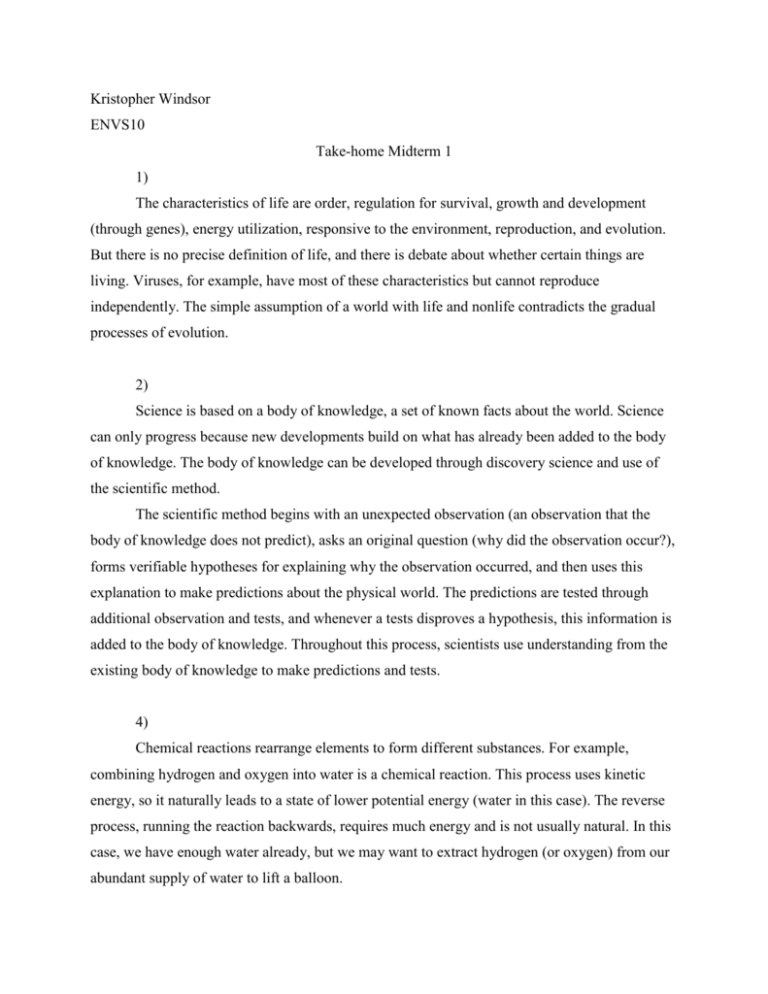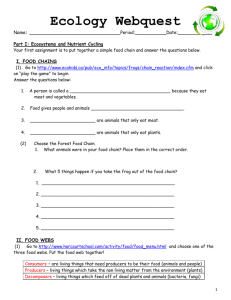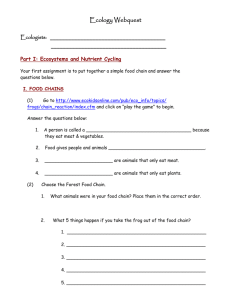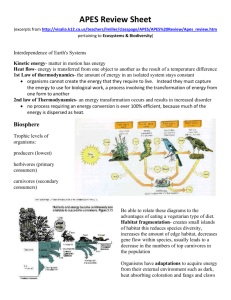uhuhu
advertisement

Kristopher Windsor ENVS10 Take-home Midterm 1 1) The characteristics of life are order, regulation for survival, growth and development (through genes), energy utilization, responsive to the environment, reproduction, and evolution. But there is no precise definition of life, and there is debate about whether certain things are living. Viruses, for example, have most of these characteristics but cannot reproduce independently. The simple assumption of a world with life and nonlife contradicts the gradual processes of evolution. 2) Science is based on a body of knowledge, a set of known facts about the world. Science can only progress because new developments build on what has already been added to the body of knowledge. The body of knowledge can be developed through discovery science and use of the scientific method. The scientific method begins with an unexpected observation (an observation that the body of knowledge does not predict), asks an original question (why did the observation occur?), forms verifiable hypotheses for explaining why the observation occurred, and then uses this explanation to make predictions about the physical world. The predictions are tested through additional observation and tests, and whenever a tests disproves a hypothesis, this information is added to the body of knowledge. Throughout this process, scientists use understanding from the existing body of knowledge to make predictions and tests. 4) Chemical reactions rearrange elements to form different substances. For example, combining hydrogen and oxygen into water is a chemical reaction. This process uses kinetic energy, so it naturally leads to a state of lower potential energy (water in this case). The reverse process, running the reaction backwards, requires much energy and is not usually natural. In this case, we have enough water already, but we may want to extract hydrogen (or oxygen) from our abundant supply of water to lift a balloon. 5) Nitrogen exists in various forms in the ground and air, moving between the two due mostly due to plants, animals, and bacteria. Nitrogen in the ground can be used by plants and the animals that eat them, but nitrogen in the air is unusable for development of DNA, so a balance of nitrogen should be kept. Humans have sped up the nitrogen cycle through its different forms, through farming (moves nitrogen to the ground) and use of fossil fuels (moves nitrogen to the air). The problem then is an imbalance of nitrogen throughout: too much nitrogen in the atmosphere causes global warming, a certain form in the atmosphere leads to acid rain, an unequal distribution of nitrogen through the soil (partially due to farming and fertilizer) can upset certain ecosystems, and the rapid movement of nitrogen depletes other minerals from the soil. By changing the plant and animal populations and using combustion for energy, humans have changed nitrogen inputs for both the soil (bio-solids and fertilizers) and air (denitrification). This causes many problems: human health issues from air quality, a lack of biodiversity as some ecosystems suffer, and global warming. A problem of this size can be reduced but not resolved. Humans have an inherent impact on the nitrogen cycle but can protect important ecosystems, use less fossil fuel and consider the issue when improving agriculture. 6) Plants use photosynthesis to convert (kinetic) sunlight into (potential) energy. Animals use cellular respiration to convert that potential energy back to kinetic energy once it is consumed. The process helps moderate the environment and prevent global warming by removing excess carbon dioxide from the air and converting heat energy into potential. 7) Selection pressure is a result of the environment that promotes certain traits of life forms. Every local environment will have features that cause life with certain traits to not live or reproduce well, allowing other life to dominate, and we attribute this promotion of certain species to selection pressures of the environment. Natural selection is the process that causes certain forms of life to become populous while others decline to extinction. This is due to selection pressures in every different habitat: species develop and spread around the earth, but as a long-term consequence of selection pressures, certain species will come to dominate certain habitats. But this process is only possible because the traits influenced by selection pressure are stored in alleles in DNA, which are passed down to descendants, allowing subtle pressures to have big long-term results. Diverse life can exist even with natural selection because there is such a variety of small environments. 8) Species rely on their respective habitats. If a habitat is divided into two parts, then the species in that habitat is divided, and each part must survive on its own. In this case, each half of the species now has less population to prevent extinction, less habitat land area to search for better conditions or food, and less chance to move to avoid predators. These things make the species more susceptible to occasional predator invasion and harsh weather, which can cause local extinction. In the case of some owls, this habitat fragmentation can prevent the sparse population from mating, causing much worse. And for any species that travels in one group throughout the habitat, fragmentation would instantly reduce the amount of land available per animal. For these reasons, habitat fragmentation promotes extinction much more than we realized at first. 9) Random mutations consistently provide new plants and animals. But we do not see a single species (not counting humans) come to overtake all the others over the whole earth because there is a diversity of environments, and different species are well-suited to different environments. Natural selection is the process that, over long periods of time, causes certain species to die out, leaving better species to thrive in each environment. This explains why diversity can exist, but not how it came to be. Species have been created through a combination of branching and non-branching evolution: if a species evolves, the less evolved species may still exist. If the two versions both exist, they may become isolated so that interbreeding does not happen; or a single species could be geographically split and then evolve in multiple directions due to natural selection in different environments. In this way, multiple species can exist. The result is biodiversity, variety in all forms of life. There are many species and small variations with species, and these are related to variations in genetic code. As different environments formed in different ways, attracting different species, diverse ecosystems formed, where some animals rely on the existence of others. Tropic forests are an example of vast biodiversity: they are home to plants, birds, bug-sized animals, mosquitoes, and possibly reptiles or larger animals, and several species of each of these can coexist.








